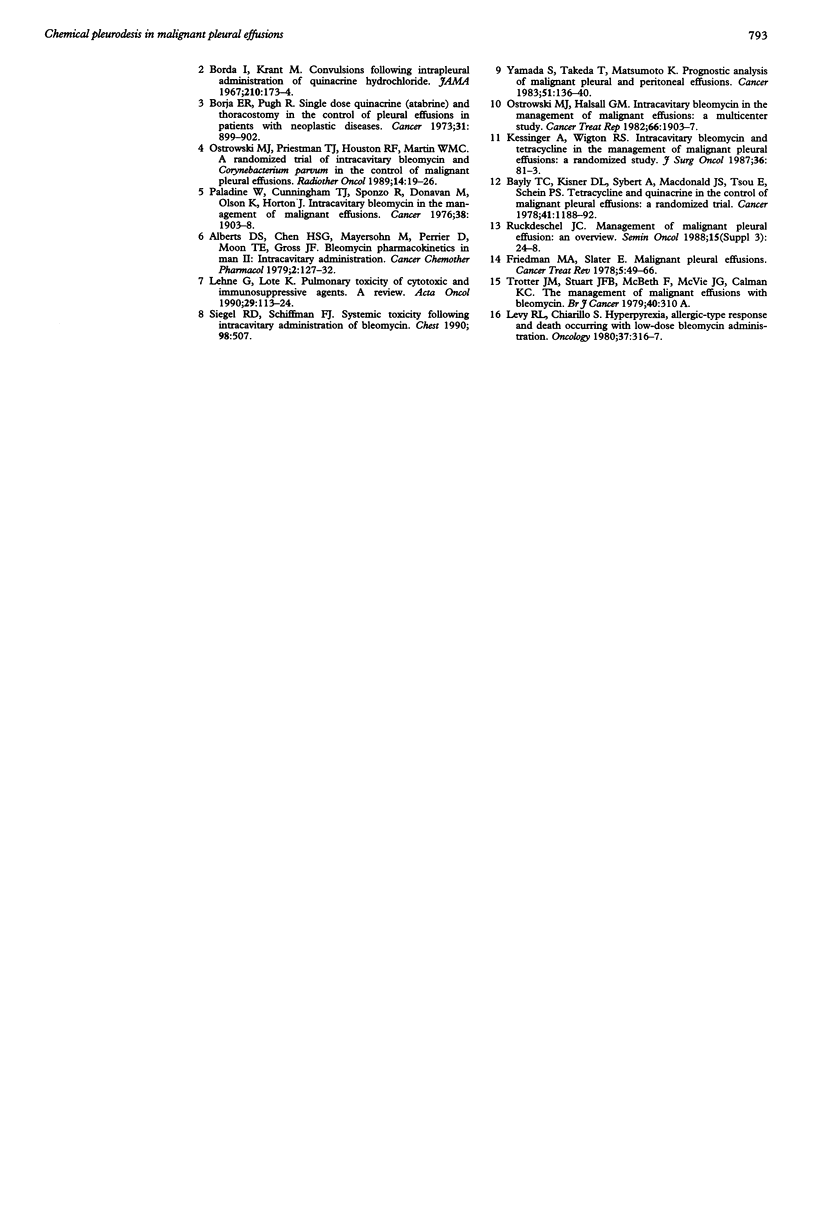Abstract
BACKGROUND--The treatment of recurrent pleural effusion in advanced malignant disease should be efficient and with tolerable side effects. Since 1983 intrathoracic instillation of the anti-malaria drug mepacrine has been used to achieve pleurodesis. The cytotoxic drug bleomycin has been claimed to be equally effective and with fewer side effects. The present study was designed to compare these two agents. METHODS--Forty patients with carcinoma and pleural effusions refractory to repeated pleural aspirations over the previous 12 weeks were randomised to receive treatment with intrathoracic instillation of mepacrine or bleomycin. Fluid volumes before and after pleurodesis, drainage time, and side effects were registered and analysed, and the response to treatment was evaluated by clinical examination and chest radiography. RESULTS--The amount of fluid produced after treatment in the patients receiving mepacrine was lower than in those receiving bleomycin, and the duration of chest drainage was shorter. After 30 days 16 of 20 in the mepacrine group responded to treatment and 10 of 20 in the bleomycin group. Most patients died during the three months observation period. Moderate side effects occurred equally in both groups. CONCLUSIONS--Chemical pleurodesis can reduce or stop pleural effusion in many patients, and in this study mepacrine appeared to be more efficient than bleomycin. A prospective study with a larger number of patients is now warranted.
Full text
PDF



Selected References
These references are in PubMed. This may not be the complete list of references from this article.
- Alberts D. S., Chen H. S., Mayersohn M., Perrier D., Moon T. E., Gross J. F. Bleomycin pharmacokinetics in man. II. Intracavitary administration. Cancer Chemother Pharmacol. 1979;2(2):127–132. doi: 10.1007/BF00254085. [DOI] [PubMed] [Google Scholar]
- Borja E. R., Pugh R. P. Single-dose quinacrine (atabrine) and thoracostomy in the control of pleural effusions in patients with neoplastic diseases. Cancer. 1973 Apr;31(4):899–902. doi: 10.1002/1097-0142(197304)31:4<899::aid-cncr2820310421>3.0.co;2-2. [DOI] [PubMed] [Google Scholar]
- Friedman M. A., Slater E. Malignant pleural effusions. Cancer Treat Rev. 1978 Jun;5(2):49–66. doi: 10.1016/s0305-7372(78)80006-1. [DOI] [PubMed] [Google Scholar]
- Kessinger A., Wigton R. S. Intracavitary bleomycin and tetracycline in the management of malignant pleural effusions: a randomized study. J Surg Oncol. 1987 Oct;36(2):81–83. doi: 10.1002/jso.2930360202. [DOI] [PubMed] [Google Scholar]
- Lee Y. W., Gisser S. D. Squamous cell carcinoma of the tongue in a nine year renal transplant survivor: a case report with a discussion of the risk of development of epithelial carcinomas in renal transplant survivors. Cancer. 1978 Jan;41(1):1–6. doi: 10.1002/1097-0142(197801)41:1<1::aid-cncr2820410101>3.0.co;2-1. [DOI] [PubMed] [Google Scholar]
- Lehne G., Lote K. Pulmonary toxicity of cytotoxic and immunosuppressive agents. A review. Acta Oncol. 1990;29(2):113–124. doi: 10.3109/02841869009126530. [DOI] [PubMed] [Google Scholar]
- Levy R. L., Chiarillo S. Hyperpyrexia, allergic-type response and death occurring with low-dose bleomycin administration. Oncology. 1980;37(5):316–317. doi: 10.1159/000225462. [DOI] [PubMed] [Google Scholar]
- Ostrowski M. J., Halsall G. M. Intracavitary bleomycin in the management of malignant effusions: a multicenter study. Cancer Treat Rep. 1982 Nov;66(11):1903–1907. [PubMed] [Google Scholar]
- Ostrowski M. J., Priestman T. J., Houston R. F., Martin W. M. A randomized trial of intracavitary bleomycin and Corynebacterium parvum in the control of malignant pleural effusions. Radiother Oncol. 1989 Jan;14(1):19–26. doi: 10.1016/0167-8140(89)90004-2. [DOI] [PubMed] [Google Scholar]
- Ovrum E., Pillgram-Larsen J. Behandling av malign pleuraeffusjon med mepakrinklorid. Tidsskr Nor Laegeforen. 1983 Apr 30;103(12):1009–1011. [PubMed] [Google Scholar]
- Paladine W., Cunningham T. J., Sponzo R., Donavan M., Olson K., Horton J. Intracavitary bleomycin in the management of malignant effusions. Cancer. 1976 Nov;38(5):1903–1908. doi: 10.1002/1097-0142(197611)38:5<1903::aid-cncr2820380506>3.0.co;2-a. [DOI] [PubMed] [Google Scholar]
- Ruckdeschel J. C. Management of malignant pleural effusion: an overview. Semin Oncol. 1988 Jun;15(3 Suppl 3):24–28. [PubMed] [Google Scholar]
- Siegel R. D., Schiffman F. J. Systemic toxicity following intracavitary administration of bleomycin. Chest. 1990 Aug;98(2):507–507. doi: 10.1378/chest.98.2.507. [DOI] [PubMed] [Google Scholar]
- Yamada S., Takeda T., Matsumoto K. Prognostic analysis of malignant pleural and peritoneal effusions. Cancer. 1983 Jan 1;51(1):136–140. doi: 10.1002/1097-0142(19830101)51:1<136::aid-cncr2820510127>3.0.co;2-x. [DOI] [PubMed] [Google Scholar]


